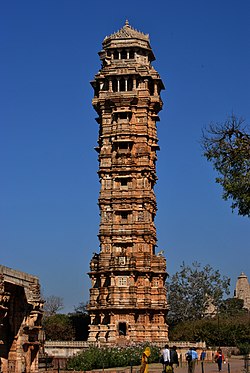Vijaya Stambha
| Vijaya Stambha | |
|---|---|
 Vijaya Stambha (Tower of Victory) | |
| Alternative names | Victory Tower |
| General information | |
| Type | Tower |
| Location | Chittorgarh, Rajasthan, India |
| Coordinates | 24°53′16″N 74°38′43″E / 24.887870°N 74.645157°E |
| Completed | 1448 CE[1] |
| Height | 37.19 m (122 ft)[1] |
| Technical details | |
| Floor count | 9[1] |
| Design and construction | |
| Architect(s) | Sutradhar Jaita[1] |
The Vijaya Stambha is a Rajput victory monument located within Chittor Fort in Chittorgarh, Rajasthan, India. The tower was constructed by the Hindu Rajput king Rana Kumbha of Mewar in 1448 CE to commemorate his victory over the army of Malwa led by Mahmud Khilji in the Battle of Sarangpur. The tower is dedicated to Hindu God Vishnu.[1][2] Colonel James Todd considered it one of the finest examples of Hindu Rajput architecture & superior to Qutub Minar.[3]
Inscriptions
[edit]To commemorate this great victory, Rana Kumbha built the great Vijay Stambha (Tower of Victory) in the fortress of Chittor. However, before this tower could be completed, the Rana had to face and vanquish the combination of two most powerful kingdoms in India at the time, those of Gujarat and Malwa, these glorious events are inscribed on the celebrated tower. Sultan Mahmud Khilji remained a prisoner in Chittor for a period of six months, after which he was liberated with ransom by Rana Kumbha. The inscribed slabs in the uppermost storey containing a detailed genealogy of the rulers of Chittaur and their deeds is ascribed to Rana Kumbha court scholar, Atri and his son Mahesh. The names of the architect, Sutradhar Jaita and his three sons who assisted him, Napa, Puja, and Poma, are carved on the fifth floor of the tower.[1]
The Vijaya Stambha is a remarkable example of religious pluralism practised by the Rajputs. The topmost story features an image of the Jain Goddess, Padmavati.[4][5]
Commemorative Postal Stamps
[edit]Commemorative stamps released by India Post

See also
[edit]References
[edit]- ^ a b c d e f "Chittaurgarh Fort, Distt. Chittaurgarh". Archaeological Survey of India. Archived from the original on 21 October 2007. Retrieved 15 April 2015.
- ^ Chandra, Satish (2004). Medieval India: From Sultanat to the Mughals-Delhi Sultanat (1206-1526) - Part One. Har-Anand Publications. p. 224. ISBN 9788124110645.
- ^ Bhanwar Singh, Thada (29 June 2023). "विजय स्तम्भ - महमूद खिलजी पर विजय की याद में बनाया". Retrieved 2 February 2024.
- ^ Chittorgarh, Shobhalal Shastri, 1928, pp. 64-65
- ^ Ali, M. Athar (January 1990). "Encounter and Efflorescence: Genesis of the Medieval Civilization". Social Scientist. 18 (1/2): 20. doi:10.2307/3517324. JSTOR 3517324.
External links
[edit] Media related to Vijaya Stambha at Wikimedia Commons
Media related to Vijaya Stambha at Wikimedia Commons


